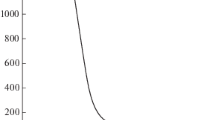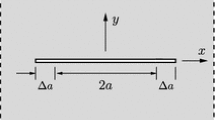Abstract
A generalization of the concept of fracture toughness of brittle materials, when subjected to multiaxial loadings, is presented. The theory characterizes the fracture strength of materials under any combination of the three basic modes of crack surfaces displacement.
With reference to three-dimensional loading systems, the fracture toughness may be represented, in theK 1 K 2 K 3 Cartesian orthogonal space, by a surface Fracture Envelope characteristic for a specified material, whose equation is determined by the (symmetric) fracture toughnessK 1c and Poisson's ratio ν.
It is shown that the most general fracture process, resulting from the combination of the opening mode of the tangential stress component and the tearing mode of the antiplane shear, may be conveniently analyzed with the aid of the generalized fracture toughness concept. From the knowledge of the Fracture Envelope relative to a structural material, a simple fracture criterion permits forecasting crack propagation for any combination of loads and geometries.
The theory is applied to mixed-mode problems to define the analytic threshold of fatigue crack growth.
Résumé On présente une généralisation du concept de ténacité à la rupture de matériaux fragiles soumis à des contraintes multiaxiales. La théorie proposée caractérise la résistance à la rupture des matériaux sous toutes les combinaisons possibles des trois modes de base des déplacements des surfaces d'une fissure.
Par rapport à un système de mise en charge à deux dimensions, la ténacité à la rupture peut être représentée dans un espace orthogonal cartésienK 1 K 2 K 3 par une Enveloppe de Rupture caractéristique d'un matériau donné dont l'équation est déterminée par la ténacité à la rupture symétriqueK c et le module de Poisson ν.
On montre que le processus de rupture le plus général qui résulte de la combinaison d'une ouverture sous l'effet de la composante tangentielle de la contrainte et d'un arrachement sous l'effet du cisaillement antiplanaire peut être analysé d'une manière satisfaisanteà l'aide du concept de ténacité à la rupture généralisée. A partir de la connaissance de l'Enveloppe de Rupture relative à un matériau de construction déterminé, un critère simple de rupture permet de prévoir la propagation d'une fissure pour toutes combinaisons de contraintes et de géométries.
La théorie est appliquée à des problèmes de fissure suivant des modes mixtes en vue de définir de manière analytique le seuil de propagation d'une fissure de fatigue.
Similar content being viewed by others
References
G. Di Leonardo,International Journal of Fracture 15 (1979) 537–552.
G.C. Sih,Mechanics of Fracture I, Noordhoff International Publishing, Leiden, Holland (1973) XXI-XLV.
G.C. Sih,International Journal of Fracture 10 (1974) 305–321.
G.C. Sih and H. Liebowitz,Fracture II (1968) 100–103.
K. Tanaka,Engineering Fracture Mechanics 6 (1974) 493–507.
Author information
Authors and Affiliations
Additional information
Operated for the U.S. Department of Energy, Contract No. DE-AC12-76N00052.
Rights and permissions
About this article
Cite this article
Di Leonardo, G. Generalized fracture toughness of brittle materials. Int J Fract 20, 313–323 (1982). https://doi.org/10.1007/BF01130615
Received:
Revised:
Issue Date:
DOI: https://doi.org/10.1007/BF01130615




